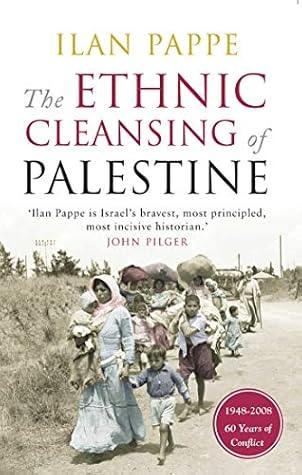More on this book
Community
Kindle Notes & Highlights
In this building, on a cold Wednesday afternoon, 10 March 1948, a group of eleven men, veteran Zionist leaders together with young military Jewish officers, put the final touches to a plan for the ethnic cleansing of Palestine. That same evening, military orders were dispatched to the units on the ground to prepare for the systematic expulsion of the Palestinians from vast areas of the country.3 The orders came with a detailed description of the methods to be employed to forcibly evict the people: large-scale intimidation; laying siege to and bombarding villages and population centres; setting
...more
One of them, Yossef Weitz, wrote in 1940: ‘it is our right to transfer the Arabs’ and ‘The Arabs should go!’39 Ben-Gurion himself, writing to his son in 1937, appeared convinced that this was the only course of action open to Zionism: ‘The Arabs will have to go, but one needs an opportune moment for making it happen, such as a war.’
Plan C spelled out clearly what punitive actions of this kind would entail: Killing the Palestinian political leadership. Killing Palestinian inciters and their financial supporters. Killing Palestinians who acted against Jews. Killing senior Palestinian officers and officials [in the Mandatory system]. Damaging Palestinian transportation. Damaging the sources of Palestinian livelihoods: water wells, mills, etc. Attacking nearby Palestinian villages likely to assist in future attacks. Attacking Palestinian clubs, coffee houses, meeting places, etc.
Indifferent as to whether these Palestinians might decide to collaborate with or oppose their Jewish State, Plan Dalet called for their systematic and total expulsion from their homeland.
This is a pattern we will see recur frequently in the history of peacemaking in Palestine, especially after the Americans became involved in 1967: up to the present day, ‘bringing peace to Palestine’ has always meant following a concept exclusively worked out between the US and Israel, without any serious consultation with, let alone regard for, the Palestinians.
In public, the leaders of the Jewish community portrayed doomsday scenarios and warned their audiences of an imminent ‘second Holocaust’. In private, however, they never used this discourse. They were fully aware that the Arab war rhetoric was in no way matched by any serious preparation on the ground.
The overt policy he and his colleagues started voicing publicly in forums such as the local People’s Assembly (the Jewish ‘parliament’ in Palestine) was the need to encourage massive Jewish immigration into the country. In smaller venues the leaders admitted that increased immigration would never be enough to counterbalance the Palestinian majority: immigration needed to be combined with other means.
the swift return to normality and the Palestinians’ wish not to become embroiled in a civil war posed a problem for a Zionist leadership determined to reduce drastically, if not totally, the number of Arabs within their future Jewish state. They needed a pretext, and this of course would be more difficult to create if the moderate Palestinian reaction continued. ‘Fortunately’ for them, at one point the army of Arab volunteers expanded their acts of hostility against Jewish convoys and settlements, thus making it easier for the Consultancy to frame the occupation and expulsion policy as a form
...more
The first step was a well-orchestrated campaign of threats. Special units of the Hagana would enter villages looking for ‘infiltrators’ (read ‘Arab volunteers’) and distribute leaflets warning the local people against cooperating with the Arab Liberation Army. Any resistance to such an incursion usually ended with the Jewish troops firing at random and killing several villagers.
Jewish troops attacked the village on 18 December 1947, and randomly started blowing up houses at the dead of night while the occupants were still fast asleep. Fifteen villagers, including five children, were killed in the attack. The incident shocked The New York Times’ correspondent, who closely followed the unfolding events. He went and demanded an explanation from the Hagana, which at first denied the operation. When the inquisitive reporter did not let go, they eventually admitted it. Ben-Gurion issued a dramatic public apology, claiming the action had been unauthorised but, a few months
...more
By the end of January, 400 Jewish settlers had died in these attacks – a high number for a community of 660,000 (but still a much lower number than the 1500 Palestinians who had so far been killed by the random bombardment and shelling of their villages and neighbourhoods). These casualties Ben-Gurion now depicted as ‘victims of a second Holocaust’. The attempt to portray Palestinians, and Arabs in general, as Nazis was a deliberate public relations ploy to ensure that, three years after the Holocaust, Jewish soldiers would not lose heart when ordered to cleanse, kill and destroy other human
...more
The Red Cross reports describe a sudden typhoid epidemic and, even with their guarded language, point to outside poisoning as the sole explanation for this outbreak.
Israeli, and in particular American, public opinion, however, succeeded in perpectuating the myth of potential destruction or a ‘second Holocaust’ awaiting the future Jewish state. Exploiting this mythology, Israel was later able to secure massive support for the state in Jewish communities around the world, while demonising the Arabs as a whole, and the Palestinians in particular, in the eyes of the general public in the US. The reality on the ground was, of course, almost the complete opposite: Palestinians were facing massive expulsion.


